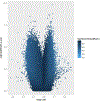Genome-wide DNA methylation investigation of glucocorticoid exposure within buccal samples
- PMID: 30821055
- PMCID: PMC6561812
- DOI: 10.1111/pcn.12835
Genome-wide DNA methylation investigation of glucocorticoid exposure within buccal samples
Abstract
Aim: Glucocorticoids play a major role in regulating the stress response, and an imbalance of glucocorticoids has been implicated in stress-related disorders. Within mouse models, CpGs across the genome have been shown to be differentially methylated in response to glucocorticoid treatment, and using the Infinium 27K array, it was shown that humans given synthetic glucocorticoids had DNA methylation (DNAm) changes in blood. However, further investigation of the extent to which glucocorticoids affect DNAm across a larger proportion of the genome is needed.
Methods: Buccal samples were collected before and after synthetic glucocorticoid treatment in the context of a dental procedure. This included 30 tooth extraction surgery patients who received 10 mg of dexamethasone. Genome-wide DNAm was assessed with the Infinium HumanMethylationEPIC array.
Results: Five CpGs showed genome-wide significant DNAm changes that were >10%. These differentially methylated CpGs were in or nearest the following genes: ZNF438, KLHDC10, miR-544 or CRABP1, DPH5, and WDFY2. Using previously published datasets of human blood gene expression changes following dexamethasone exposure, a significant proportion of genes with false-discovery-rate-adjusted significant CpGs were also differentially expressed. A pathway analysis of the genes with false-discovery-rate-adjusted significant CpGs revealed significant enrichment of olfactory transduction, pentose and glucuronate interconversions, ascorbate and aldarate metabolism, and steroid hormone biosynthesis pathways.
Conclusion: High-dose synthetic glucocorticoid administration in the setting of a dental procedure was significantly associated with DNAm changes within buccal samples. These findings are consistent with prior findings of an influence of glucocorticoids on DNAm in humans.
Keywords: DNA methylation; dexamethasone; epigenomics; glucocorticoids; stress (psychological).
© 2019 The Authors. Psychiatry and Clinical Neurosciences © 2019 Japanese Society of Psychiatry and Neurology.
Conflict of interest statement
Disclosure Statement
GS is a founder of Predelix Medical LLC, although that entity has no relevance or relationship to this manuscript. All other authors declare no conflicts of interest.
Figures
References
-
- Kessler R, Davis C, Kendler KS. Childhood adversity and adult psychiatric disorder in the US National Comorbidity Survey. Psychological Medicine 1997;27(5):1101–9. - PubMed
-
- Kendler KS, Karkowski LM, Prescott CA. Causal relationship between stressful life events and the onset of major depression. Am J Psychiatry 1999;156(6):837–41. - PubMed
-
- Hammen C Stress and depression. Annu Rev Clin Psychol 2005;1:293–319. - PubMed
-
- Paykel ES, Myers JK, Dienelt MN, Klerman GL, Lindenth JJ, Pepper MP. Life Events and Depression - a Controlled Study. Arch Gen Psychiat 1969;21(6):753. - PubMed
-
- Kessler RC, Berglund P, Demler O, Jin R, Koretz D, Merikangas KR, et al. The epidemiology of major depressive disorder: results from the National Comorbidity Survey Replication (NCS-R). JAMA 2003;289(23):3095–105. - PubMed
MeSH terms
Substances
Grants and funding
LinkOut - more resources
Full Text Sources
Medical


